story and photos by Kayte Deioma
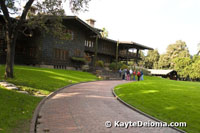 You can’t decide at the spur of the moment that you’d like to tour JPL, but you can look at those rain-bearing clouds and opt for an hour inside the cozy confines of the Gamble House. You don’t really visit the Gamble House to learn about the history of the Gamble family, of the Cincinnati-based Procter & Gamble Company, who summered here. The Gamble House is a masterwork of architects Henry and Charles Greene, who also built many other Arts and Crafts Movement houses in the area.
You can’t decide at the spur of the moment that you’d like to tour JPL, but you can look at those rain-bearing clouds and opt for an hour inside the cozy confines of the Gamble House. You don’t really visit the Gamble House to learn about the history of the Gamble family, of the Cincinnati-based Procter & Gamble Company, who summered here. The Gamble House is a masterwork of architects Henry and Charles Greene, who also built many other Arts and Crafts Movement houses in the area.
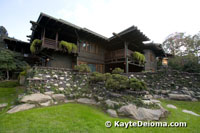 Commissioned in 1907 by David B. and Mary Gamble, the Gamble house incorporates Swiss and Japanese aesthetics and an Arts and Crafts philosophy into a quintessentially California structure. Long eaves shelter the house from the sun. Sleeping porches take advantage of cool evening breezes. Natural redwood shakes covering the exterior were designed to blend with the rustic Arroyo setting that surrounded the house before the area was developed.
Commissioned in 1907 by David B. and Mary Gamble, the Gamble house incorporates Swiss and Japanese aesthetics and an Arts and Crafts philosophy into a quintessentially California structure. Long eaves shelter the house from the sun. Sleeping porches take advantage of cool evening breezes. Natural redwood shakes covering the exterior were designed to blend with the rustic Arroyo setting that surrounded the house before the area was developed.
In 1966 the Gamble House was given by the Gamble heirs to the City of Pasadena and the University of Southern California School of Architecture. The structure remains unchanged almost 100 years after its construction. A conservation project in 2004 spruced the place up a bit and added some invisible protection, but left the original architects’ work essentially intact.
The Gamble House Tour
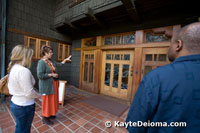 Hour-long docent-led tours begin on the side terrace and take you through the three-panel front door. The panels are adorned with leaded stained glass patterned with oak tree trunks and ginkgo leaves designed by Charles Greene, the more artistic brother. Charles also designed most of the furnishings in the house.
Hour-long docent-led tours begin on the side terrace and take you through the three-panel front door. The panels are adorned with leaded stained glass patterned with oak tree trunks and ginkgo leaves designed by Charles Greene, the more artistic brother. Charles also designed most of the furnishings in the house.
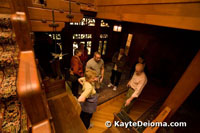 The first thing you notice inside the house is how dark it is. Although the house was built with electricity, the bulbs are very dim and the walls throughout are of dark wood. Our guide uses a flashlight to point out the smooth joinery and the rounded corners and edges on all the Burma teak features and furnishings in the entry hall.
The first thing you notice inside the house is how dark it is. Although the house was built with electricity, the bulbs are very dim and the walls throughout are of dark wood. Our guide uses a flashlight to point out the smooth joinery and the rounded corners and edges on all the Burma teak features and furnishings in the entry hall.
The tour takes you through the guest room, with its custom nickel silver beds and floral motif lanterns.
The kitchen is probably the brightest room in the house with light-colored clear and birdseye maple cupboards. The woodwork here, as 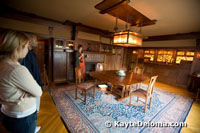 in the neighboring butler’s pantry and servants’ dining porch show just as much attention to detail as in the parts of the house inhabited by the family.
in the neighboring butler’s pantry and servants’ dining porch show just as much attention to detail as in the parts of the house inhabited by the family.
In the dining room, San Domingo Mahogany woodwork is accented with ebony pegs in the walls, built-in cabinets and dining set. Stained glass windows with a nature motif reflect the colors in the glass box light suspended over the dining room table.
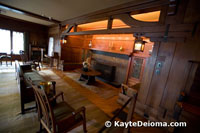 There are two single beds in the master bedroom and one double bed in the boys’ room. The boys are reported to have slept out on the sleeping porch, since they only visited the house on summer breaks from boarding school.
There are two single beds in the master bedroom and one double bed in the boys’ room. The boys are reported to have slept out on the sleeping porch, since they only visited the house on summer breaks from boarding school.
A stairway leads from the upstairs hall to the attic, now used as a conference room. A locked door leads, we’re told, to private rooms, formerly the servants’ quarters, which have been used since 1970 by two USC architecture students in the Scholars in Residence program who receive a 12-month rent-free furnished living space and studios.
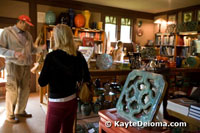 The tour exits downstairs through Mr. Gambles den and back out to the terrace, from where you can explore the small garden or make your way to the Bookstore in the former garage. A walking tour map of other Greene and Greene houses in the neighborhood is available for purchase in the Bookstore.
The tour exits downstairs through Mr. Gambles den and back out to the terrace, from where you can explore the small garden or make your way to the Bookstore in the former garage. A walking tour map of other Greene and Greene houses in the neighborhood is available for purchase in the Bookstore.
The Gamble House
4 Westmoreland Place (a private drive off of Orange Grove)
Pasadena, CA 91103
Phone: (626) 793-3334
Bookstore: (626) 449-4178
Note: Tour tickets are sold in the bookstore.
www.gamblehouse.org

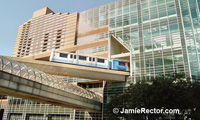 If you’re in downtown Detroit on business and find yourself with a little free time on a rainy or snowy day, your connection to anywhere you might want to be in the central business district is the Detroit People Mover. This light rail system that makes a loop through 13 stations is built high above traffic and provides excellent views of the city, its landmarks and the Detroit River. Since eight of the People Mover stations are inside buildings, you have access to over nine million square feet of retail shopping, entertainment venues, hotels, offices, civic center services and residential space without ever going outside.
If you’re in downtown Detroit on business and find yourself with a little free time on a rainy or snowy day, your connection to anywhere you might want to be in the central business district is the Detroit People Mover. This light rail system that makes a loop through 13 stations is built high above traffic and provides excellent views of the city, its landmarks and the Detroit River. Since eight of the People Mover stations are inside buildings, you have access to over nine million square feet of retail shopping, entertainment venues, hotels, offices, civic center services and residential space without ever going outside.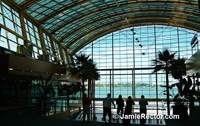 The People Mover stops at the Renaissance Center, Detroit’s most recognizable architectural landmark. Six high rise office towers surround the 73 story cylindrical Marriot Hotel at its center.The Ren Cen, as its known locally, has gone through its ups and downs since Henry Ford II and a group of local developers opened it in 1977. GM bought the complex in 2001 and did a complete makeover that got its final touches in 2005. The Ren Cen offers a one-hour tour four times a day, six days per week. The tour starts at the General Motors Wintergarden, a five-story glass atrium with two levels of local and international chain boutiques and restaurants. Other highlights
The People Mover stops at the Renaissance Center, Detroit’s most recognizable architectural landmark. Six high rise office towers surround the 73 story cylindrical Marriot Hotel at its center.The Ren Cen, as its known locally, has gone through its ups and downs since Henry Ford II and a group of local developers opened it in 1977. GM bought the complex in 2001 and did a complete makeover that got its final touches in 2005. The Ren Cen offers a one-hour tour four times a day, six days per week. The tour starts at the General Motors Wintergarden, a five-story glass atrium with two levels of local and international chain boutiques and restaurants. Other highlights 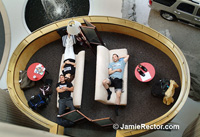 include GM World, a showcase for past, present and future GM cars; a tour of the movie theatre and an elevator ride up to the 72 nd floor to admire the view – 30 miles on a clear day.
include GM World, a showcase for past, present and future GM cars; a tour of the movie theatre and an elevator ride up to the 72 nd floor to admire the view – 30 miles on a clear day.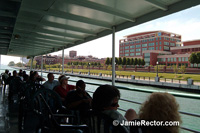 Also at the Renaissance Center stop, just off the Promenade on the Detroit River is the
Also at the Renaissance Center stop, just off the Promenade on the Detroit River is the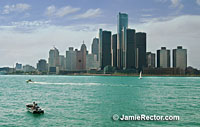 keeping company with Sailboats and barges making their own way along the mile-wide waterway. The tour passes the Mayor’s residence, the Manoogian Mansion, nestled along the shore. The vessel continues to meander under the MacArthur Bridge and around Belle Isle and back down on the Canadian side. Friendly Canadians wave to the ship as it floats past downtown Windsor and waterfront residences and eventually under the mighty Ambassador Bridge before it heads back along Hart Plaza and Joe Lewis Arena into downtown Detroit.
keeping company with Sailboats and barges making their own way along the mile-wide waterway. The tour passes the Mayor’s residence, the Manoogian Mansion, nestled along the shore. The vessel continues to meander under the MacArthur Bridge and around Belle Isle and back down on the Canadian side. Friendly Canadians wave to the ship as it floats past downtown Windsor and waterfront residences and eventually under the mighty Ambassador Bridge before it heads back along Hart Plaza and Joe Lewis Arena into downtown Detroit.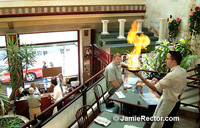 Greektown is the People Mover stop you want for great food and a cultural experience. The street is strung with flags and lined with restaurants, bakeries and shops all offering the look, feel and taste of walking through a street in Greece. The price range varies from a nice basic restaurant to an elegant eating experience. Make sure to check out the Saganaki at the multi-level New Parthenon Restaurant. The flaming cheese is always fun to watch and this establishment is reputed to be the inventor of this Detroit-Greek delicacy. “Opa!” Once your tummy is full from any of the more than 20 restaurants, bakeries or shops, you can empty your pockets at the Greektown Casino on the corner with free validated parking in their parking structure.
Greektown is the People Mover stop you want for great food and a cultural experience. The street is strung with flags and lined with restaurants, bakeries and shops all offering the look, feel and taste of walking through a street in Greece. The price range varies from a nice basic restaurant to an elegant eating experience. Make sure to check out the Saganaki at the multi-level New Parthenon Restaurant. The flaming cheese is always fun to watch and this establishment is reputed to be the inventor of this Detroit-Greek delicacy. “Opa!” Once your tummy is full from any of the more than 20 restaurants, bakeries or shops, you can empty your pockets at the Greektown Casino on the corner with free validated parking in their parking structure.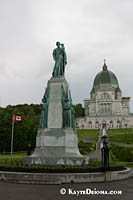 Montreal is a great city for exploring on your own and any of the venues in this issue would be perfectly appropriate to visit alone. But I somehow think of spiritual places as good solo destinations to take a quiet moment and ponder the universe. St. Joseph’s Oratory on Mount Royal is a nice spot for such pondering.
Montreal is a great city for exploring on your own and any of the venues in this issue would be perfectly appropriate to visit alone. But I somehow think of spiritual places as good solo destinations to take a quiet moment and ponder the universe. St. Joseph’s Oratory on Mount Royal is a nice spot for such pondering.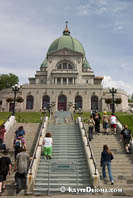 St. Joseph’s Oratory, at 856 feet (263 meters) above sea level, is the highest point in Montreal. From street level to the top of the dome is 506 feet (155 meters). That’s a lot of stairs to climb, especially if you are a pilgrim climbing the stairs on your knees. If you don’t feel like scaling the 233 steps up to the Crypt level, a shuttle will drive you from the gate house at street level up to the entrance.
St. Joseph’s Oratory, at 856 feet (263 meters) above sea level, is the highest point in Montreal. From street level to the top of the dome is 506 feet (155 meters). That’s a lot of stairs to climb, especially if you are a pilgrim climbing the stairs on your knees. If you don’t feel like scaling the 233 steps up to the Crypt level, a shuttle will drive you from the gate house at street level up to the entrance.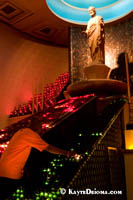 The Arrow Guide suggests entering the building from the side entrance into the Votive Chapel (marked with the number 1), a long corridor lined with votive altars. Each one is a tribute to St. Joseph in his various functions as model for workers, guardian of virgins, support of families, terror of demons, consolation of the afflicted, hope of the sick, patron of the dying, and protector of the Church. Halfway down the hall in the center lamp rack, 3,500 of the chapel’s 10,000 votive candles rise up to a statue of Joseph with arms outstretched. Between the altars, wooden crutches of those healed by Brother André are displayed hanging in rows. Notably, there are no aluminum crutches or other evidence of people being healed since the pious man’s passing.
The Arrow Guide suggests entering the building from the side entrance into the Votive Chapel (marked with the number 1), a long corridor lined with votive altars. Each one is a tribute to St. Joseph in his various functions as model for workers, guardian of virgins, support of families, terror of demons, consolation of the afflicted, hope of the sick, patron of the dying, and protector of the Church. Halfway down the hall in the center lamp rack, 3,500 of the chapel’s 10,000 votive candles rise up to a statue of Joseph with arms outstretched. Between the altars, wooden crutches of those healed by Brother André are displayed hanging in rows. Notably, there are no aluminum crutches or other evidence of people being healed since the pious man’s passing.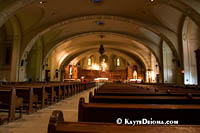 To the left is the Crypt Church, so named for the flattened arches supporting the ceiling and its position at the foot of the Basilica. Rather than the traditional cross over the altar, a nine-foot statue of St. Joseph takes pride of place. The Christ statue on the large crucifix to the right of the altar has worn feet from the hands of many pilgrims. A giant statue of Brother André looms in front of the stained glass windows on the right wall. The colorful panels represent events in the life of St. Joseph.
To the left is the Crypt Church, so named for the flattened arches supporting the ceiling and its position at the foot of the Basilica. Rather than the traditional cross over the altar, a nine-foot statue of St. Joseph takes pride of place. The Christ statue on the large crucifix to the right of the altar has worn feet from the hands of many pilgrims. A giant statue of Brother André looms in front of the stained glass windows on the right wall. The colorful panels represent events in the life of St. Joseph.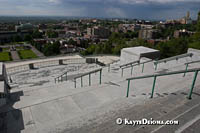 Doors at the back of the Crypt Church will take you to the escalators up to the Concourse Hall where you will find access to the terrace which provides a view of Montreal down the west side of Mount Royal. You’ll also find restrooms and drinking fountains on this floor and the stairway to theBrother André Display. You have to take the stairs, as the escalator bypasses this area. This exhibit contains recreations of the doorkeeper’s lodge at Notre Dame College, Brother André’s office and the hospital room where he died, some of them with original features. However the most important artifact in this display is the reliquary with Brother André’s heart.
Doors at the back of the Crypt Church will take you to the escalators up to the Concourse Hall where you will find access to the terrace which provides a view of Montreal down the west side of Mount Royal. You’ll also find restrooms and drinking fountains on this floor and the stairway to theBrother André Display. You have to take the stairs, as the escalator bypasses this area. This exhibit contains recreations of the doorkeeper’s lodge at Notre Dame College, Brother André’s office and the hospital room where he died, some of them with original features. However the most important artifact in this display is the reliquary with Brother André’s heart.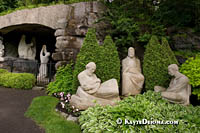 Back down on the Concourse level you can exit to the Way of the Crossand the Oratory Gardens. The larger-than-life Stations of the Cross lead through the gardens to the Pool and Fountain of Redemption. It’s a beautiful place to dwell and contemplate in nice weather, but if it’s raining significantly, you might want to proceed up the escalator to the OratoryMuseum.
Back down on the Concourse level you can exit to the Way of the Crossand the Oratory Gardens. The larger-than-life Stations of the Cross lead through the gardens to the Pool and Fountain of Redemption. It’s a beautiful place to dwell and contemplate in nice weather, but if it’s raining significantly, you might want to proceed up the escalator to the OratoryMuseum.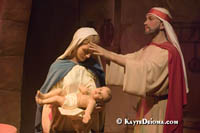 The front galleries are used for rotating exhibits from the Museum’s significant collection of artwork related to the Holy Family, St. Joseph and Brother André. Part of every year includes a Nativity Exhibit with 200 to 300 of the Museum’s thousands of crčches from around the world from the 6 th century through the present. Each annual exhibit includes at least 100 nativity scenes that have not been exhibited before. They range from miniatures to life size, from Indian needlework to Vietnamese Mother of Pearl, Sudanese ebony and incense paste from Singapore. The permanent exhibit at the back of the Museum is a series of wax figures behind glass portraying scenes from the life of St. Joseph.
The front galleries are used for rotating exhibits from the Museum’s significant collection of artwork related to the Holy Family, St. Joseph and Brother André. Part of every year includes a Nativity Exhibit with 200 to 300 of the Museum’s thousands of crčches from around the world from the 6 th century through the present. Each annual exhibit includes at least 100 nativity scenes that have not been exhibited before. They range from miniatures to life size, from Indian needlework to Vietnamese Mother of Pearl, Sudanese ebony and incense paste from Singapore. The permanent exhibit at the back of the Museum is a series of wax figures behind glass portraying scenes from the life of St. Joseph.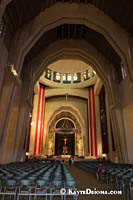 Above the museum is the Basilica. You can go back outside at this level to admire the 60 foot Corinthian columns close up and enjoy the view. This is the highest point you can climb if you’re ascending the 283 stars up the front of the Oratory. The interior dome rises 195 feet (60 m) above the floor. The cavernous space holds 2200 people seated in the metal folding chairs or 10,000 standing. It is rather stark in contrast to many basilicas in the world and less inviting than the cozy Crypt below. The dome is the third largest in the world after St. Peter’s in Rome and an African tribute to St. Peter’s, the Basilica of Our Lady of Peace in Ivory Coast. The stained glass windows depict some of the miraculous events in Canadian history attributed to the intervention of St. Joseph. The Grand Organ at the back of the Basilica has 5,811 pipes, with the longest 32 feet (9.75 m) tall. Organ recitals are every Sunday at 3:30 all year with a series of guest performances on Wednesday evenings in the summer.
Above the museum is the Basilica. You can go back outside at this level to admire the 60 foot Corinthian columns close up and enjoy the view. This is the highest point you can climb if you’re ascending the 283 stars up the front of the Oratory. The interior dome rises 195 feet (60 m) above the floor. The cavernous space holds 2200 people seated in the metal folding chairs or 10,000 standing. It is rather stark in contrast to many basilicas in the world and less inviting than the cozy Crypt below. The dome is the third largest in the world after St. Peter’s in Rome and an African tribute to St. Peter’s, the Basilica of Our Lady of Peace in Ivory Coast. The stained glass windows depict some of the miraculous events in Canadian history attributed to the intervention of St. Joseph. The Grand Organ at the back of the Basilica has 5,811 pipes, with the longest 32 feet (9.75 m) tall. Organ recitals are every Sunday at 3:30 all year with a series of guest performances on Wednesday evenings in the summer.